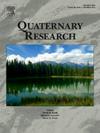Holocene hydroclimatic variability recorded in sediments from Maddox Lake (northern California Coast Range)
IF 1.8
3区 地球科学
Q3 GEOGRAPHY, PHYSICAL
引用次数: 2
Abstract
Abstract Perspectives on past climate using lake sediments are critical for assessing modern and future climate change. These perspectives are especially important for water-stressed regions such as the western United States. One such region is northwestern California (CA), where Holocene-length hydroclimatic records are scarce. Here, we present a 9000-year, relative lake level record from Maddox Lake (CA) using a multi-indicator approach. The Early Holocene is characterized by variably low lake levels with a brief excursion to wetter climates/relative highstand ca. 8.4–8.06 cal ka BP, possibly related to the 8.2 ka cold event and changing Atlantic Meridional Overturning Circulation (AMOC). From 5.2–0.55 cal ka BP, Maddox Lake experienced a long-term regression, tracking changes in summer-winter insolation, tropical and northeast Pacific SSTs, and the southward migration of the ITCZ. This gradual regression culminated in a pronounced relative lowstand during the Medieval Climatic Anomaly (MCA). A marked relative highstand followed the MCA, correlative to the Little Ice Age. The latter reflects a far-field response to North Atlantic volcanism, solar variability, and possibly changes in AMOC and Arctic sea ice extent. Our results further confirm the hydroclimatic sensitivity of northwest California to various forcings including those emanating from the North Atlantic.Maddox湖(加利福尼亚海岸山脉北部)沉积物中记录的全新世水文气候变化
摘要利用湖泊沉积物对过去气候的展望对于评估现代和未来气候变化至关重要。这些观点对于美国西部等缺水地区尤为重要。其中一个地区是加利福尼亚州西北部,那里的全新世水文气候记录很少。在这里,我们使用多指标方法展示了来自马多克斯湖(CA)的9000年相对湖泊水位记录。全新世早期的特点是湖泊水位变化低,短暂迁移到更潮湿的气候/相对高水位约8.4–8.06卡BP,可能与8.2卡冷事件和不断变化的大西洋经向翻转环流(AMOC)有关。从5.2–0.55 cal ka BP,Maddox湖经历了长期回归,跟踪了夏季-冬季日照、热带和东北太平洋SST以及ITCZ向南迁移的变化。这种逐渐的回归在中世纪气候异常(MCA)期间达到了显著的相对低点。MCA之后出现了明显的相对高位,与小冰河时代相关。后者反映了北大西洋火山活动、太阳变化以及AMOC和北极海冰范围的可能变化的远场响应。我们的结果进一步证实了加利福尼亚西北部的水文气候对各种强迫的敏感性,包括来自北大西洋的强迫。
本文章由计算机程序翻译,如有差异,请以英文原文为准。
求助全文
约1分钟内获得全文
求助全文
来源期刊

Quaternary Research
地学-地球科学综合
CiteScore
4.70
自引率
8.70%
发文量
57
审稿时长
3 months
期刊介绍:
Quaternary Research is an international journal devoted to the advancement of the interdisciplinary understanding of the Quaternary Period. We aim to publish articles of broad interest with relevance to more than one discipline, and that constitute a significant new contribution to Quaternary science. The journal’s scope is global, building on its nearly 50-year history in advancing the understanding of earth and human history through interdisciplinary study of the last 2.6 million years.
 求助内容:
求助内容: 应助结果提醒方式:
应助结果提醒方式:


